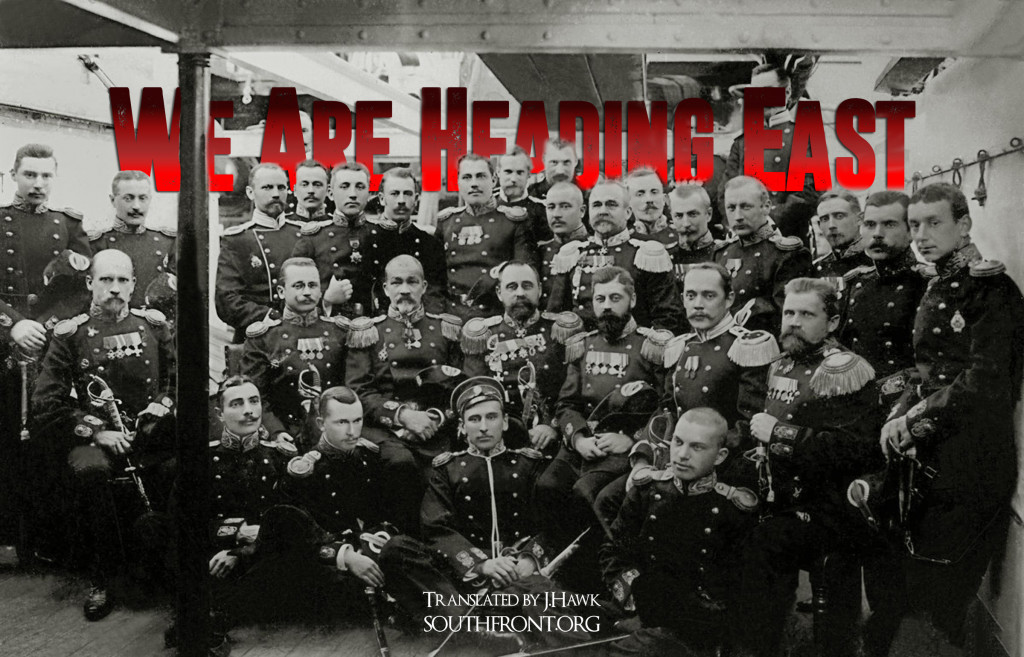Moscow does not wish to divide terrorists into “ours” and “not ours.”

Photo: Officers of the battleship “Prince Suvorov”, Russian Empire, 1904
Original by Yevgeniy Satanovskiy (the president of the Middle East Institute) published by Military-Industrial Complex News; translated from Russian by J.Hawk exclusively for SouthFront
The appearance of Russian Air Force in Syria in the form of an aviation regiment and supporting services dramatically changed the situation in the region. Though in principle one could have expected something else: external observers apparently believed Moscow will continue to follow the Soviet scenario.
In other words, it would blame the West for all the problems, deploy a clumsy military machine that could be easily attacked with covert (or overt) support for the militants, like Senator McCain is currently demanding. It would be interesting to know, will the West deliver modern shoulder-launched SAMs to the terrorist groups, considering what happened between the US and terror groups after the 9/11 terror attacks. Because it’s self-evident they could be used to attack any aircraft, helicopters, and UAVs, starting with the American ones. And Russia would not leave such actions unanswered.
Who’s crying for Syria?
Contrary to all the predictions, Russia acted stealthily, swiftly, and effectively. Which was to be expected, based on the analysis of its operations in Ossetia and Crimea. It was extraordinarily “polite” and constructive, but also firmly proposed everyone concerned to collaborate or get out of the way and not interfere in its fight against terrorists in a way it considered appropriate. Assad’s government ensured the legitimacy of its operations in Syria. What is more: if the Russian leadership makes the corresponding decision, it will have a free hand to conduct combat operations in Iraq, since that country’s government has invited Russia to do so. For that purpose a coordinating center in Baghdad, intended to oversee counter-terror operations by Iraq, Syria, Iran, and Russia has already been established.
“The four country security pact has taken US officials by surprise, who admitted they barely understand Russia’s long-term strategy in the region.”
This is a slap to Obama’s cheek, whose clumsy coalition consisting of 62 member states has been operating over the skies of Iraq for over a year without much success. Which partly explains its predictions of Russian failure in Syria, although Putin’s statements concerning the US and Obama himself have been more restrained. Granted a ground component in the shape of the Syrian army, Kurd and Druze formations, Shia detachments and the Iranians, local Kurds and Shia, the Russian Air Force is more effective than the USAF and its allies by two orders of magnitude. But nobody has prevented the US from establishing similar contacts in order to prevent such level of confusion concerning aims, tasks, and allies.

Photo: http://vpk-news.ru/
The main motif of all Western publications is that Russian aviation is bombing non-ISIL targets. It’s partly correct–the Homs strikes were directed against pro-Saudi and pro-Turkish groups. They went back from the Idlib salient to that city after realizing that after Russian arrival at Latakia that axis of advance has been blocked. But it doesn’t mean there are no IS supporters in the area: they tried to advance toward Homs from Palmyra several times, conducting diversionary strikes in order to stop Damascus forces from advancing on the city. The losses from the first Russian air raids were more than perceptible, hence Kerry’s “concern” and Saudi leadership’s hysteria, from MFA to the UN permanent representative on down. It’s a revealing reaction: Russia is destroying the Islamist conglomerate created with great effort by Riyadh. Unlike the Syrians, Russian pilots aren’t chasing groups of 20-30 militants, but are hitting underground tunnels, HQs, arsenals, and vehicular bomb workshops. Between September 30 and October 1, Russian aircraft hit islamist HQs and fortifications in Idlib, on the territory controlled by pro-Saudi Jaish al-Fath.Syrian army’s resilience was due to its air superiority. It allowed government forces to resist islamist groups while being short of personnel. Hence the endless demands by the “friends of Syria” such as Turkey and the Arab monarchies to declare a no-fly zone over Turkey. Once several key airbases were captured and most aircraft became non-operational, Assad’s enemies were able to seize the initiative, but not for long. Since, unlike the coalition, Russian aircraft operate in concert with the Syrian army, they have timely intelligence and the ability to place aircraft direction officers on the front lines. As far as the use of aviation against non-IS targets is concerned, it is being used where it’s necessary to restore the front line, irrespective of what the islamists call themselves. The objective is to stabilize the situation on critical sectors and launch a counteroffensive.This effort will be decried and ridiculed in the West, but mainly by the media. It’s comical to publicly express concern that the “wrong” islamists are being bombed. Nobody has removed Djabhat al-Nusra from the US State Department terror watch list. The US is concerned about the bombing of those islamist groups which they are quietly using for their own purposes. These are mainly Ahrar ash-Sham and Djunud ash-Sham. That’s why the theme of “suffering civilians” is being pursued, even though nobody can provide any evidence. We should note that the current maximum task in Syria is the stabilization of the front and creating conditions for Assad army and Kurdish offensive toward Raqqah. The capture of the IS Syrian capital which funnels illegal oil to Turkey will cause IS military activity to die down in both Syria and Iraq. That’s more important than pushing militants out of the Yarmuk Palestinian refugee camp or clearing Aleppo.
The Anti-Assad Project is Finished
The US believes that Russian actions are motivated by the desire to position itself as a global player, escape the sanctions regime, and either discount or freeze the Ukrainian theme. In actuality, other than the defense of national interests, this move was motivated by the plainly visible demonstration of the beginning of the end of the unipolar world which took shape after USSR’s collapse. Moreover, Russia has made a significant step toward Iran in the Iran-Saudi conflict. The Arab monarchy lobbyist dreams of bring them closer to Russia will most likely remain just that. Moreover, Moscow has also made headway in winning the sympathies of the Western public which prefers politicians capable of acting effectively, not politically correctly. That public understands Russia’s actions in Syria. What is more, the official reaction by Washington and Brussels will be all the more harsh, since the issue is no longer Syria, but rather a new model of global decisionmaking.

Photo: http://vpk-news.ru/
Russia’s escalation of the fight against the IS led many politicians to worry about IS expansion into Russia. Along the following lines: in retaliation for Russia’s position on Syria, IS launches a terror war in Russia. It’s obvious that Russia’s Syria stance has caused concern in Saudi Arabia, Qatar, and Turkey which are the sponsors of “Syrian resistance,” of its radicalization and islamization. It happened because Europeans and Americans turned a blind eye and took a neutral position. Riyadh and Doha planted jihadism in Syria, using unlimited financial support and material aid. This allowed them to saturate the anti-Assad forces with foreign “volunteers” and create a counterweight to government forces to minimize Iran’s influence in Syria and Lebanon. If it weren’t for their sponsorship of Islamists, the Syria conflict would have long passed its peak, although the IED war and the negative Sunni attitudes toward the government would have remained.
As far as one can tell, the project which Putin outlined at the UN consist of preserving the official Damascus in Syria’s politics as the only guarantee it won’t turn into a “failed state.” Once Assad’s opponents and their sponsors the situation is unwinnable, one can transition to incorporating the Sunni elite into Syria’s politics and economy, just as something similar happened with the Chechen elite in Russia. Of course, Chechnya did not suffer from a sectarian conflict. Syria does, but that Sunni incorporation is possible is suggested by Assad the elder’s actions who created a viable system of political power and rewards. It’s not important whether Assad the younger will head up this incorporation. His own words say as much.
Saudi Arabia does not want to take this into account. They want Assad’s immediate departure. After the failure to undermine the Iranian nuclear deal and unsuccessful Yemen operations, only a success in Syria can preserve Saudi Arabia’s status as a regional power. But the kingdom can’t finance militants for the Yemen, Syria, and Iraq wars endlessly. It’s budget is experiencing problems due to the oil price crisis. If the current trends continue, the kingdom has enough gold/currency reserves for two-three years. Riyadh will start feeling pressure from Iran in about a year, due to the growth of Tehran’s financial resources as the sanctions weaken. Therefore Saudi Arabia and Qatar in the medium term will not have the resources to launch large-scale jihadism in Northern Caucasus. They might be able to pay for high-profile terror strikes, but not the anarchy on the scale of the 1990s. The situation in the republics of Northern Caucasus is not the same, either. Chechya, in particular, has experience of a war on its territory, which nobody wants to repeat. So that IS or al-Nusra expansion into Northern Caucasus is only a theoretical problem.
Moreover, Russian military presence in Syria ties down jihadi forces on its territory. If combat operations continue and the Syrian regime preserves its resilience, the likelihood of jihadi hot-spots in Northern Caucasus is very low. The main requirement, money, is also lacking, since Arab monarchies are also financing conflicts in Syria, Iraq, and Yemen, while Qatari in Syria and in the Sinai. The dwindling flow of volunteers is heading in that direction as well. Attempts to make IS self-financing in the event funding is cut off by relying on the smuggling of oil, grain, and flour, of archaeological artifacts, and on hostage-taking, are doomed to failure. The realization that there is no war without money recently forced the US to offer an award for information about IS funding channels. Although that’s mainly a propaganda move. First of all, they already know everything (the absence of sanctions against Turkish banks and firms cooperating with the IS is a separate topic), and secondly, special services are paying agents, not strangers.
A Coalition of Coalitions
It is interesting to follow the reactions to Russia, Syria, Iran, and Iraq a joint information center in Baghdad to coordinate the fight against the IS. The US is of the opinion this decision created a “new reality”, and forced them to try to understand Russia’s plans. The Wall Street Journal writes: “the four-country security pact…surprised US officials who admitted they barely understand Russia’s long-term strategy in the region.” It notes Kerry left open the possibility of coordination, if not cooperation, between the White House and the Kremlin, in the fight against the IS. In practical terms the center, which was dubbed by the Western press a joint general staff of the four countries, means there are liaison officers in Bahgdad who monitor the situation and send joint recommendations to their respective capitals. The center’s objective is, in addition to the exchange of information, political in nature. Not for nothing was its creation officially announced on the eve of Russian president’s program speech at the UN General Assembly.
At the UN, the Russian president sketched out the possibility of creating an alternative anti-IS coalition on the eve of his meeting with the US president, guaranteeing the participation of everyone who earlier was forbidden by the US, mainly Iran and Syria. At the same time the US is cooperating with Iran, for example during Iranian arms deliveries by US transport aircraft from Erbil to the Kobani enclave. Moscow offered to legalize this process and formalize it using official documents, but Washington couldn’t take that step. In part because it would have damaged US relations with the Arab monarchies, and Riyadh especially. The most optimistic outcome of the Russian-US consultations could have been a delineation of coalition spheres of responsibility and establishing contacts in order to prevent accidental mutual strikes and to coordinate operations. A more realistic outcome is that each coalition will do what it pleases, putting out “red flags” and coordinating after the fact.
In conclusion we note that Russia’s air operations in Syria and the diplomatic breakthrough in Iraq allowed Russia to restore the image it lost in the post-Soviet times. Only the strong and self-sufficient are respected in the Middle East. To be sure, Moscow is much more careful than in the old times, which explains the offered level of coordination with the US and Israel and its abiding by the accepted rules of the game to an extent greater than Washington’s. Which undoubtedly is a big plus. Are there risks for Russia? Naturally. But without its intervention in Syria at a critical time at the minimal level which we are observing these risks would have been greater. Which is clearly not taken into account by the critics of Russia’s government, especially internal ones…





